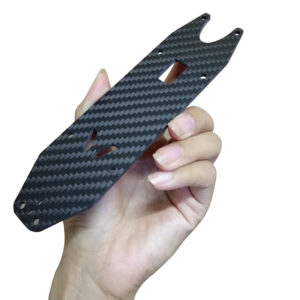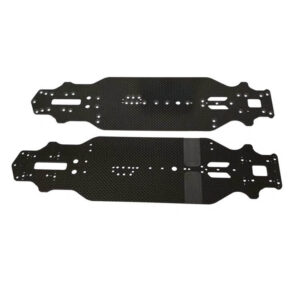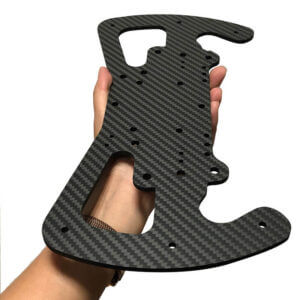Introduction
Carbon fiber cutting service have transformed various industries by providing precise and high-quality solutions for manufacturing lightweight and strong components. As technology advances, the demand for materials that offer both durability and minimal weight increases, driving the popularity of carbon fiber. This composite material is renowned for its exceptional strength-to-weight ratio, making it ideal for applications requiring high performance and reliability.
Several key industries benefit immensely from carbon fiber cutting service. These include aerospace, automotive, drones, RC cars, sim racing, sports and recreation, medical devices, renewable energy, marine, and robotics. Each of these sectors leverages the unique properties of carbon fiber to enhance performance, efficiency, and longevity. This article explores the specific advantages that carbon fiber cutting services bring to these industries, illustrating why this material has become indispensable in modern manufacturing.

Aerospace and Drone Industry
The Critical Need for Lightweight and Strong Materials
The aerospace and drone industries demand materials that are both lightweight and incredibly strong. The weight of the materials directly impacts fuel efficiency and overall performance. Similarly, in drone manufacturing, reducing weight while maintaining structural integrity is crucial for enhancing flight time and maneuverability. Carbon fiber perfectly fits these requirements, offering a superior strength-to-weight ratio that surpasses traditional materials like aluminum and steel.
Examples of Aerospace Components
Carbon fiber is extensively used in the aerospace sector, including in wing sections, fuselage panels, and tail assemblies. These components benefit from carbon fiber’s ability to withstand high stress and strain without adding unnecessary weight to the aircraft. The result is a lighter aircraft that achieves better fuel efficiency and greater range, leading to cost savings and reduced environmental impact.
Use of Carbon Fiber in Drone Frames
Drones, whether used for recreational, commercial, or military purposes, also benefit from carbon fiber’s properties. Carbon fiber frames provide the necessary strength to endure impacts and vibrations while remaining light enough to not hinder flight performance. This balance is essential for drones to achieve optimal stability, agility, and endurance during flight.

Benefits of Using Carbon Fiber in Aerospace and Drones
Using carbon fiber in both aerospace and drone applications offers several benefits:
- Improved Fuel Efficiency: Reduced weight leads to lower fuel consumption and extended flight ranges.
- Enhanced Performance: Carbon fiber components enhance flight stability and maneuverability.
- Durability: Carbon fiber’s strength ensures longer-lasting components that can withstand the rigors of flight, reducing maintenance and replacement frequency.
Automotive Industry
Increasing Demand for Lightweight Materials
The automotive industry strives to improve fuel efficiency and vehicle performance by reducing the weight of vehicles. Lightweight materials directly contribute to better fuel economy and reduced emissions. Carbon fiber, with its exceptional strength-to-weight ratio, is increasingly used in automotive applications.
Use of Carbon Fiber in High-Performance and Luxury Cars
High-performance and luxury car manufacturers use carbon fiber extensively in various parts, including body panels, chassis, and interior components. In high-performance cars, carbon fiber enhances speed and agility by significantly reducing the vehicle’s weight without compromising structural integrity. Luxury car makers use carbon fiber to add sophistication and exclusivity, appealing to discerning customers.
Benefits
The benefits of using carbon fiber in the automotive industry include:
- Weight Reduction: Leading to improved fuel efficiency and reduced greenhouse gas emissions.
- Enhanced Safety and Performance: Carbon fiber components withstand higher stress and impact, providing better protection in collisions.
- Better Handling and Agility: Reduced weight allows for more responsive steering and improved acceleration, crucial for performance and luxury vehicles.
RC Cars
Application of Carbon Fiber in RC Car Chassis
Competitive racing RC cars benefit greatly from carbon fiber chassis. Carbon fiber’s lightweight nature allows for faster speeds and more agile handling, while its strength ensures the chassis can withstand high-speed racing impacts.

Advantages
The primary advantages of using carbon fiber in RC car chassis are:
- Weight Reduction: Lighter chassis means quicker acceleration and higher top speeds.
- Improved Handling: Better weight distribution and balance result in enhanced control.
- Durability: Carbon fiber can endure frequent use and collisions without significant damage.
Examples of Competitive Advantages
- Enhanced Speed and Acceleration: Superior speed and acceleration give racers a competitive edge.
- Improved Handling and Control: Precision in navigating turns and obstacles leads to better performance on the track.
- Durability and Longevity: Fewer repairs and replacements allow racers to focus on performance.
- Aesthetic Appeal: Carbon fiber’s distinctive appearance adds a high-tech, professional look to RC cars.
Sim Racing
Importance of Realistic and Durable Materials
Sim racing demands realistic and durable materials to enhance the virtual racing experience. Enthusiasts and professionals seek equipment that mimics the feel and performance of real racing cars. Carbon fiber’s lightweight yet sturdy properties make it ideal for sim racing gear.
Use of Carbon Fiber in Sim Racing Equipment
Carbon fiber is used in steering wheels and pedal systems in sim racing setups. Carbon fiber steering wheels replicate the weight and responsiveness of actual racing car wheels. The rigidity ensures precise and consistent force feedback, crucial for a realistic racing experience. Pedal systems also benefit from carbon fiber, contributing to more accurate pedal pressure and quicker response times.

Benefits
Using carbon fiber in sim racing equipment offers several benefits:
- Enhanced Realism: Replicates the feel and performance of real racing car parts.
- Durability: Withstands extensive use and high levels of force feedback.
- Performance Improvement: Quicker and more precise inputs enhance overall performance.
- Aesthetic Appeal: Adds a high-tech, professional look to sim racing setups.
Sports and Recreation
Application in Sporting Goods
Carbon fiber is widely used in sporting goods such as bicycles, golf clubs, tennis rackets, and fishing rods. Its lightweight and strong characteristics make it ideal for high-performance equipment that can withstand competitive and recreational use.
The Role of Carbon Fiber in Enhancing Performance
In sports, equipment performance can significantly impact an athlete’s success. Carbon fiber enhances performance by providing a superior strength-to-weight ratio. For example, in cycling, carbon fiber frames allow for faster speeds and better maneuverability. In golf, carbon fiber shafts offer increased swing speed and greater distance. The material’s ability to absorb vibrations also contributes to improved comfort and control.
Benefits for Athletes
The benefits of carbon fiber for athletes include:
- Increased Performance: Lightweight equipment allows athletes to perform at higher levels.
- Enhanced Durability: Can withstand significant stress and impact without compromising integrity.
- Improved Comfort and Control: Vibration-dampening properties reduce the risk of injury and fatigue.
- Competitive Edge: Better performance, durability, and comfort translate to better competition results.
Medical Devices
Importance of Biocompatibility
Materials used in medical devices must meet stringent biocompatibility standards to ensure they do not cause adverse reactions when in contact with the human body. Carbon fiber is an excellent choice for medical applications due to its biocompatibility, ensuring safety in medical devices.
Examples of Carbon Fiber Medical Applications
- Prosthetics: Lightweight and strong, carbon fiber prosthetics provide enhanced mobility and comfort.
- Surgical Instruments: Durable and sterilizable, carbon fiber instruments ensure precision and reliability.
- Imaging Equipment: Used in MRI and X-ray tables for its non-magnetic and lightweight properties.
Benefits
The use of carbon fiber in medical devices has several advantages, including:
- Enhanced Patient Comfort: Lightweight devices are more comfortable for patients to use.
- Increased Durability: Withstands repeated use and sterilization without degrading.
- Improved Precision and Performance: Ensures better control and accuracy in medical procedures.
- Safety and Biocompatibility: Does not cause adverse reactions in patients.
Renewable Energy
Use of Carbon Fiber in Wind Turbine Blades
Renewable energy, particularly wind energy, has advanced with the use of carbon fiber in wind turbine blades. Carbon fiber’s strength-to-weight ratio allows for longer, more efficient, and more durable blades than traditional materials.
Advantages of Carbon Fiber
The advantages of using carbon fiber in wind turbine blades include:
- Increased Efficiency: Longer, thinner blades capture more wind energy.
- Weight Reduction: Reduces mechanical stress, leading to lower maintenance costs.
- Enhanced Durability: Resists fatigue and environmental stressors.
- Improved Performance: Precise aerodynamic designs maximize energy capture.
Contribution to Sustainability
The use of carbon fiber in renewable energy applications supports sustainability by enhancing the efficiency and lifespan of wind turbines. This contributes to reducing the carbon footprint and reliance on fossil fuels, promoting a cleaner and more sustainable energy future.
Marine Industry
Importance of Lightweight and Corrosion-Resistant Materials
The marine industry requires materials that are lightweight and resistant to corrosion caused by seawater. Carbon fiber meets these requirements, making it an ideal material for various marine applications.
Use of Carbon Fiber in Marine Applications
Carbon fiber is used in boat hulls, masts, and other structural components. Its lightweight nature allows for faster and more fuel-efficient vessels, while its corrosion resistance ensures durability in harsh marine environments.
Benefits
The benefits of using carbon fiber in the marine industry include:
- Improved Performance: Lightweight materials enhance speed and fuel efficiency.
- Enhanced Durability: Corrosion resistance ensures longer-lasting components.
- Reduced Maintenance: Durable materials reduce the need for frequent repairs and replacements.
- Versatility: Carbon fiber can be molded into various shapes and sizes, allowing for innovative marine designs.
Robotics
Demand for Lightweight and Strong Materials
Robotics applications require materials that are both lightweight and strong to optimize performance and efficiency. Carbon fiber is an excellent choice for robotic components, offering the necessary strength without adding unnecessary weight.
Use of Carbon Fiber in Robotic Components
Carbon fiber is used in robotic arms, frames, and other structural parts. Its lightweight properties enhance the agility and speed of robots, while its strength ensures durability and reliability.
Benefits
The benefits of using carbon fiber in robotics include:
- Enhanced Agility: Lightweight materials allow for quicker and more precise movements.
- Increased Durability: Strong materials ensure long-lasting and reliable components.
- Improved Efficiency: Reduced weight contributes to better energy efficiency.
- Versatility: Carbon fiber can be customized to meet specific design and performance requirements.
Conclusion
Carbon fiber cutting service offer numerous benefits across various industries, providing lightweight, strong, and durable components that enhance performance and efficiency. From aerospace and automotive to sports and medical devices, carbon fiber has become indispensable in modern manufacturing.
By opting for carbon fiber cutting service, industries can leverage the latest advancements in material science and engineering to achieve superior results. Whether you need components for drones, RC cars, or renewable energy applications, carbon fiber offers the versatility and quality required to excel.
For more information on carbon fiber cutting service and to explore our range of solutions, please contact us or visit our website to learn more about how carbon fiber can benefit your next project.


![[object Object]](https://carbonfiber-cnc.com/wp-content/uploads/2023/05/wendy.jpg)